Taxation Law Case Study: Individual Assignment for CLWM4100
VerifiedAdded on 2023/06/07
|6
|1740
|384
Case Study
AI Summary
This case study assignment delves into various aspects of Australian taxation law, providing a comprehensive analysis of tax residency, capital gains tax (CGT), and general deductions. The solution begins by examining the tax residency of an international shipping company based in Singapore, applying relevant legislation like s.6(1) ITAA 1936 and case law such as Huq Wang Bank Berhad v Commissioner of Taxation [2016] HCA 45 to determine its Australian tax resident status. The assignment then proceeds to analyze the CGT implications of selling different assets, including a car, vacant land, shares, antiques, jewelry, and a quota, referencing specific sections of the ITAA 1997, such as s. 204-430, s. 149-10, s. 104-5, s. 115-25(1), s. 108-20(1), and s. 110-25. Finally, the case study examines the deductibility of interest and advertisement campaign expenses under s. 8-1 ITAA 1997, considering case law like Sun Newspapers Ltd and Associated Newspapers Ltd v. Federal Commissioner of Taxation (1938) 61 CLR 33 to determine whether the expenditures are revenue or capital in nature. The solution provides detailed calculations, legal analysis, and conclusions, offering a thorough understanding of the relevant tax principles.
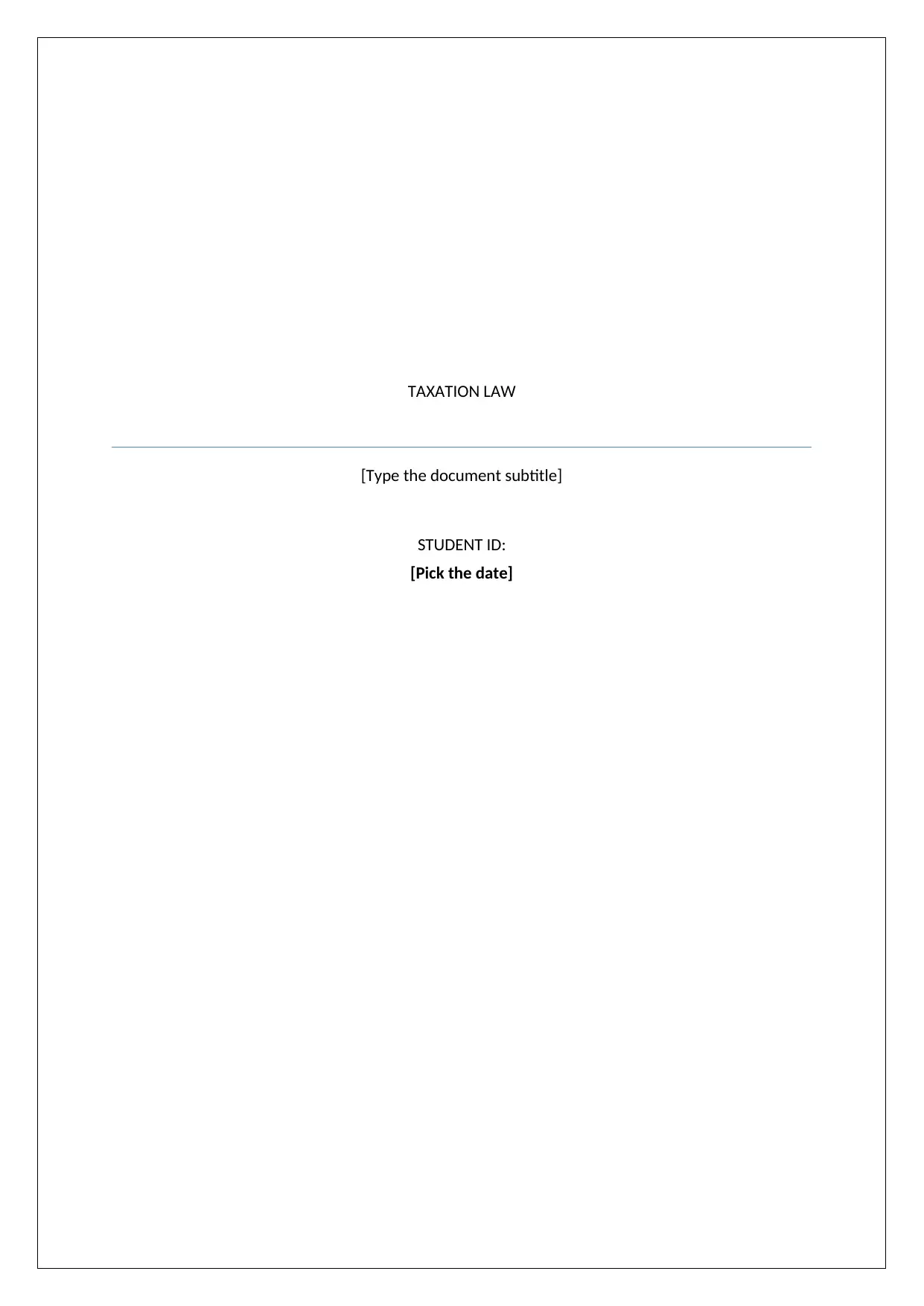
TAXATION LAW
[Type the document subtitle]
STUDENT ID:
[Pick the date]
[Type the document subtitle]
STUDENT ID:
[Pick the date]
Paraphrase This Document
Need a fresh take? Get an instant paraphrase of this document with our AI Paraphraser
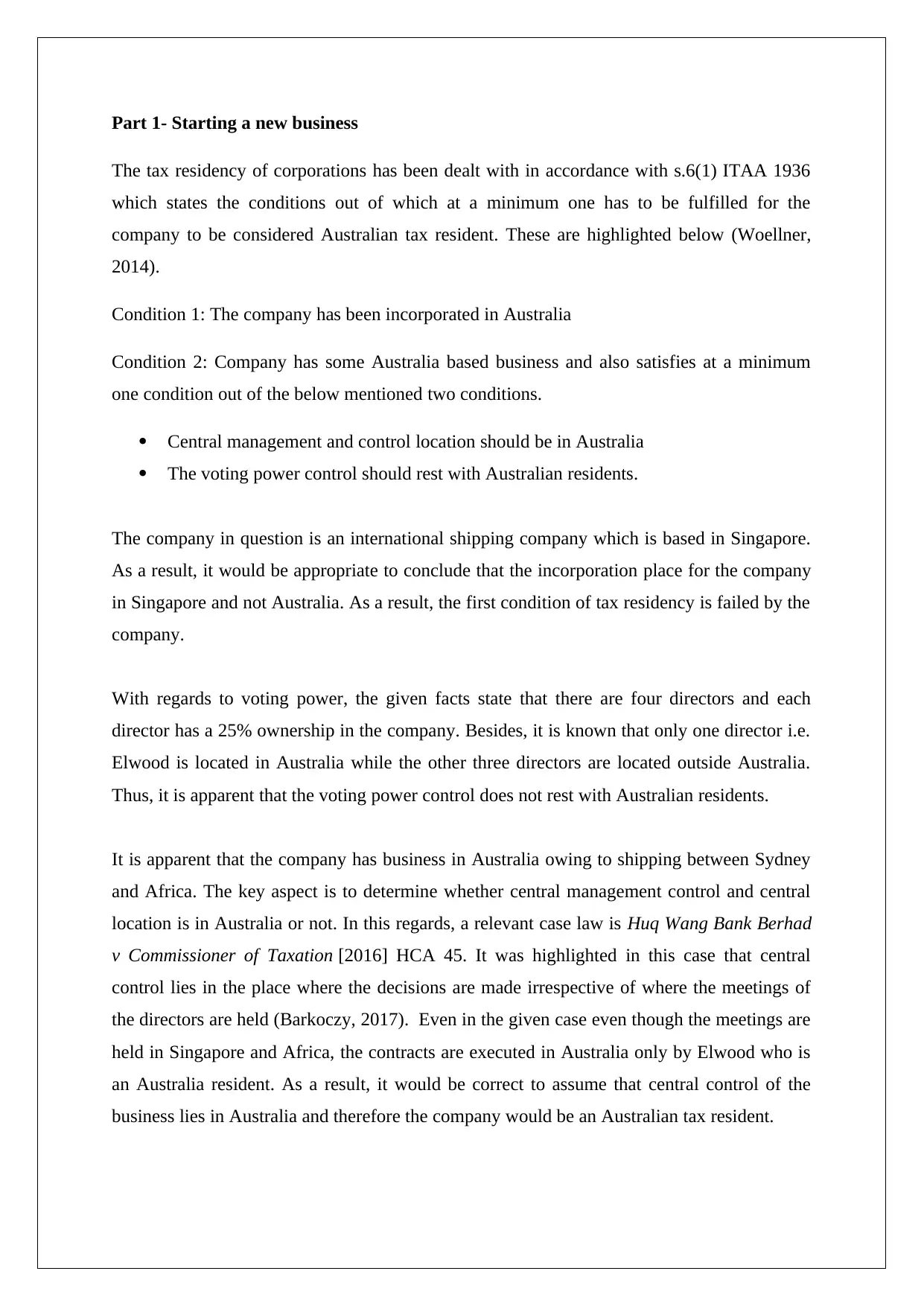
Part 1- Starting a new business
The tax residency of corporations has been dealt with in accordance with s.6(1) ITAA 1936
which states the conditions out of which at a minimum one has to be fulfilled for the
company to be considered Australian tax resident. These are highlighted below (Woellner,
2014).
Condition 1: The company has been incorporated in Australia
Condition 2: Company has some Australia based business and also satisfies at a minimum
one condition out of the below mentioned two conditions.
Central management and control location should be in Australia
The voting power control should rest with Australian residents.
The company in question is an international shipping company which is based in Singapore.
As a result, it would be appropriate to conclude that the incorporation place for the company
in Singapore and not Australia. As a result, the first condition of tax residency is failed by the
company.
With regards to voting power, the given facts state that there are four directors and each
director has a 25% ownership in the company. Besides, it is known that only one director i.e.
Elwood is located in Australia while the other three directors are located outside Australia.
Thus, it is apparent that the voting power control does not rest with Australian residents.
It is apparent that the company has business in Australia owing to shipping between Sydney
and Africa. The key aspect is to determine whether central management control and central
location is in Australia or not. In this regards, a relevant case law is Huq Wang Bank Berhad
v Commissioner of Taxation [2016] HCA 45. It was highlighted in this case that central
control lies in the place where the decisions are made irrespective of where the meetings of
the directors are held (Barkoczy, 2017). Even in the given case even though the meetings are
held in Singapore and Africa, the contracts are executed in Australia only by Elwood who is
an Australia resident. As a result, it would be correct to assume that central control of the
business lies in Australia and therefore the company would be an Australian tax resident.
The tax residency of corporations has been dealt with in accordance with s.6(1) ITAA 1936
which states the conditions out of which at a minimum one has to be fulfilled for the
company to be considered Australian tax resident. These are highlighted below (Woellner,
2014).
Condition 1: The company has been incorporated in Australia
Condition 2: Company has some Australia based business and also satisfies at a minimum
one condition out of the below mentioned two conditions.
Central management and control location should be in Australia
The voting power control should rest with Australian residents.
The company in question is an international shipping company which is based in Singapore.
As a result, it would be appropriate to conclude that the incorporation place for the company
in Singapore and not Australia. As a result, the first condition of tax residency is failed by the
company.
With regards to voting power, the given facts state that there are four directors and each
director has a 25% ownership in the company. Besides, it is known that only one director i.e.
Elwood is located in Australia while the other three directors are located outside Australia.
Thus, it is apparent that the voting power control does not rest with Australian residents.
It is apparent that the company has business in Australia owing to shipping between Sydney
and Africa. The key aspect is to determine whether central management control and central
location is in Australia or not. In this regards, a relevant case law is Huq Wang Bank Berhad
v Commissioner of Taxation [2016] HCA 45. It was highlighted in this case that central
control lies in the place where the decisions are made irrespective of where the meetings of
the directors are held (Barkoczy, 2017). Even in the given case even though the meetings are
held in Singapore and Africa, the contracts are executed in Australia only by Elwood who is
an Australia resident. As a result, it would be correct to assume that central control of the
business lies in Australia and therefore the company would be an Australian tax resident.
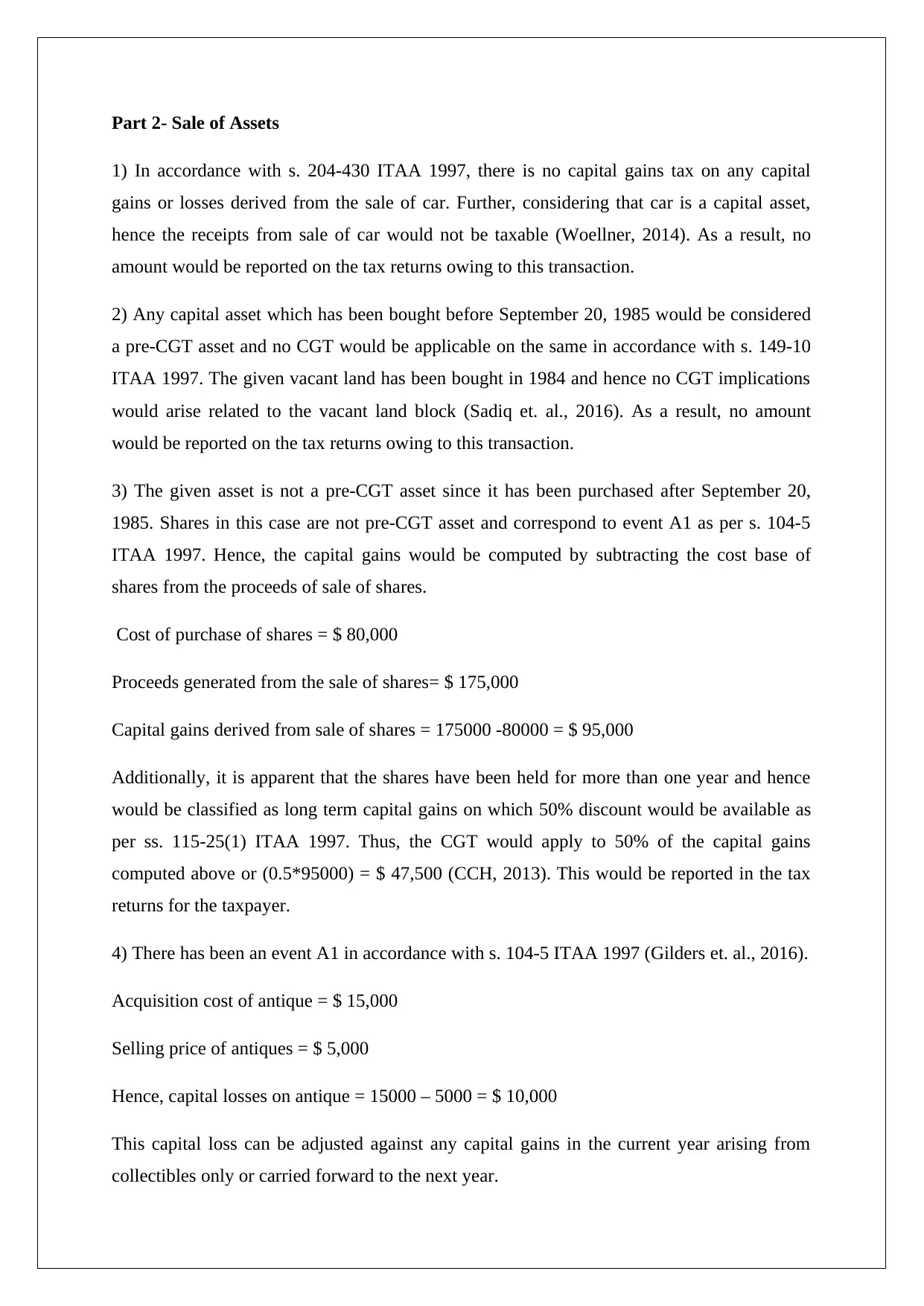
Part 2- Sale of Assets
1) In accordance with s. 204-430 ITAA 1997, there is no capital gains tax on any capital
gains or losses derived from the sale of car. Further, considering that car is a capital asset,
hence the receipts from sale of car would not be taxable (Woellner, 2014). As a result, no
amount would be reported on the tax returns owing to this transaction.
2) Any capital asset which has been bought before September 20, 1985 would be considered
a pre-CGT asset and no CGT would be applicable on the same in accordance with s. 149-10
ITAA 1997. The given vacant land has been bought in 1984 and hence no CGT implications
would arise related to the vacant land block (Sadiq et. al., 2016). As a result, no amount
would be reported on the tax returns owing to this transaction.
3) The given asset is not a pre-CGT asset since it has been purchased after September 20,
1985. Shares in this case are not pre-CGT asset and correspond to event A1 as per s. 104-5
ITAA 1997. Hence, the capital gains would be computed by subtracting the cost base of
shares from the proceeds of sale of shares.
Cost of purchase of shares = $ 80,000
Proceeds generated from the sale of shares= $ 175,000
Capital gains derived from sale of shares = 175000 -80000 = $ 95,000
Additionally, it is apparent that the shares have been held for more than one year and hence
would be classified as long term capital gains on which 50% discount would be available as
per ss. 115-25(1) ITAA 1997. Thus, the CGT would apply to 50% of the capital gains
computed above or (0.5*95000) = $ 47,500 (CCH, 2013). This would be reported in the tax
returns for the taxpayer.
4) There has been an event A1 in accordance with s. 104-5 ITAA 1997 (Gilders et. al., 2016).
Acquisition cost of antique = $ 15,000
Selling price of antiques = $ 5,000
Hence, capital losses on antique = 15000 – 5000 = $ 10,000
This capital loss can be adjusted against any capital gains in the current year arising from
collectibles only or carried forward to the next year.
1) In accordance with s. 204-430 ITAA 1997, there is no capital gains tax on any capital
gains or losses derived from the sale of car. Further, considering that car is a capital asset,
hence the receipts from sale of car would not be taxable (Woellner, 2014). As a result, no
amount would be reported on the tax returns owing to this transaction.
2) Any capital asset which has been bought before September 20, 1985 would be considered
a pre-CGT asset and no CGT would be applicable on the same in accordance with s. 149-10
ITAA 1997. The given vacant land has been bought in 1984 and hence no CGT implications
would arise related to the vacant land block (Sadiq et. al., 2016). As a result, no amount
would be reported on the tax returns owing to this transaction.
3) The given asset is not a pre-CGT asset since it has been purchased after September 20,
1985. Shares in this case are not pre-CGT asset and correspond to event A1 as per s. 104-5
ITAA 1997. Hence, the capital gains would be computed by subtracting the cost base of
shares from the proceeds of sale of shares.
Cost of purchase of shares = $ 80,000
Proceeds generated from the sale of shares= $ 175,000
Capital gains derived from sale of shares = 175000 -80000 = $ 95,000
Additionally, it is apparent that the shares have been held for more than one year and hence
would be classified as long term capital gains on which 50% discount would be available as
per ss. 115-25(1) ITAA 1997. Thus, the CGT would apply to 50% of the capital gains
computed above or (0.5*95000) = $ 47,500 (CCH, 2013). This would be reported in the tax
returns for the taxpayer.
4) There has been an event A1 in accordance with s. 104-5 ITAA 1997 (Gilders et. al., 2016).
Acquisition cost of antique = $ 15,000
Selling price of antiques = $ 5,000
Hence, capital losses on antique = 15000 – 5000 = $ 10,000
This capital loss can be adjusted against any capital gains in the current year arising from
collectibles only or carried forward to the next year.
⊘ This is a preview!⊘
Do you want full access?
Subscribe today to unlock all pages.

Trusted by 1+ million students worldwide
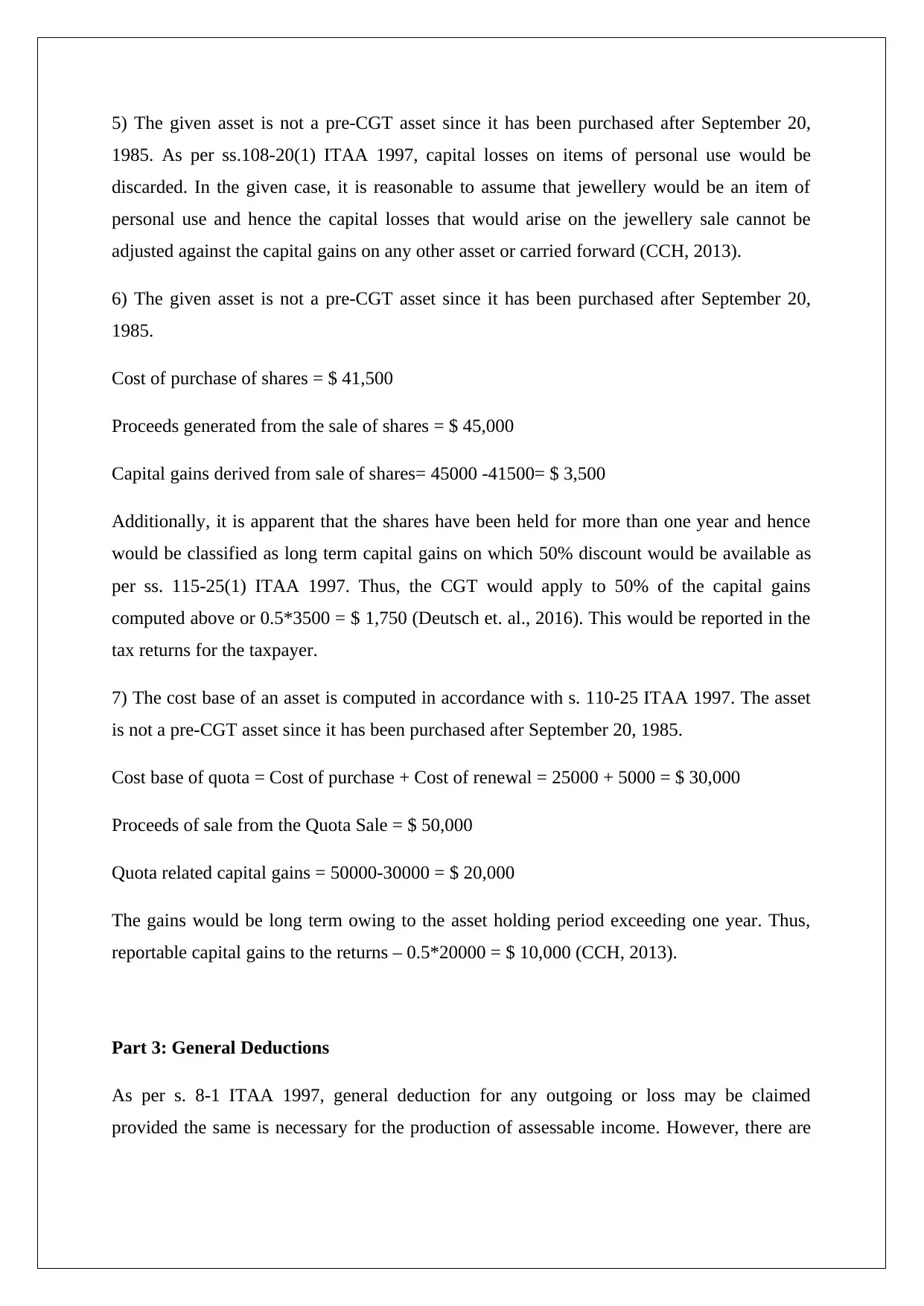
5) The given asset is not a pre-CGT asset since it has been purchased after September 20,
1985. As per ss.108-20(1) ITAA 1997, capital losses on items of personal use would be
discarded. In the given case, it is reasonable to assume that jewellery would be an item of
personal use and hence the capital losses that would arise on the jewellery sale cannot be
adjusted against the capital gains on any other asset or carried forward (CCH, 2013).
6) The given asset is not a pre-CGT asset since it has been purchased after September 20,
1985.
Cost of purchase of shares = $ 41,500
Proceeds generated from the sale of shares = $ 45,000
Capital gains derived from sale of shares= 45000 -41500= $ 3,500
Additionally, it is apparent that the shares have been held for more than one year and hence
would be classified as long term capital gains on which 50% discount would be available as
per ss. 115-25(1) ITAA 1997. Thus, the CGT would apply to 50% of the capital gains
computed above or 0.5*3500 = $ 1,750 (Deutsch et. al., 2016). This would be reported in the
tax returns for the taxpayer.
7) The cost base of an asset is computed in accordance with s. 110-25 ITAA 1997. The asset
is not a pre-CGT asset since it has been purchased after September 20, 1985.
Cost base of quota = Cost of purchase + Cost of renewal = 25000 + 5000 = $ 30,000
Proceeds of sale from the Quota Sale = $ 50,000
Quota related capital gains = 50000-30000 = $ 20,000
The gains would be long term owing to the asset holding period exceeding one year. Thus,
reportable capital gains to the returns – 0.5*20000 = $ 10,000 (CCH, 2013).
Part 3: General Deductions
As per s. 8-1 ITAA 1997, general deduction for any outgoing or loss may be claimed
provided the same is necessary for the production of assessable income. However, there are
1985. As per ss.108-20(1) ITAA 1997, capital losses on items of personal use would be
discarded. In the given case, it is reasonable to assume that jewellery would be an item of
personal use and hence the capital losses that would arise on the jewellery sale cannot be
adjusted against the capital gains on any other asset or carried forward (CCH, 2013).
6) The given asset is not a pre-CGT asset since it has been purchased after September 20,
1985.
Cost of purchase of shares = $ 41,500
Proceeds generated from the sale of shares = $ 45,000
Capital gains derived from sale of shares= 45000 -41500= $ 3,500
Additionally, it is apparent that the shares have been held for more than one year and hence
would be classified as long term capital gains on which 50% discount would be available as
per ss. 115-25(1) ITAA 1997. Thus, the CGT would apply to 50% of the capital gains
computed above or 0.5*3500 = $ 1,750 (Deutsch et. al., 2016). This would be reported in the
tax returns for the taxpayer.
7) The cost base of an asset is computed in accordance with s. 110-25 ITAA 1997. The asset
is not a pre-CGT asset since it has been purchased after September 20, 1985.
Cost base of quota = Cost of purchase + Cost of renewal = 25000 + 5000 = $ 30,000
Proceeds of sale from the Quota Sale = $ 50,000
Quota related capital gains = 50000-30000 = $ 20,000
The gains would be long term owing to the asset holding period exceeding one year. Thus,
reportable capital gains to the returns – 0.5*20000 = $ 10,000 (CCH, 2013).
Part 3: General Deductions
As per s. 8-1 ITAA 1997, general deduction for any outgoing or loss may be claimed
provided the same is necessary for the production of assessable income. However, there are
Paraphrase This Document
Need a fresh take? Get an instant paraphrase of this document with our AI Paraphraser

certain negative limbs identified in ss. 8-1(2) ITAA 1997 as per which the expenditure must
not be capital or else tax deduction under s.8-1 cannot be availed (Deutsch et. al., 2016).
Interest – Interest expense would be deductible as per s. 8-1 if the principal amount is
invested for production of assessable income. In the given base, it is apparent that the
taxpayer has invested the money in buying the showroom before the arrival of the first cars
from Fiji. Also, despite the restriction imposed by the government on imports from Fiji, some
cars are still being imported from Fiji and hence some assessable income would be produce3d
by the business owing to which the given interest cost would be considered as tax deductible
under the aegis under s. 8-1 ITAA 1997 (Barkoczy, 2015).
Advertisement Campaign – The availability of the general deduction on advertisement
campaign would be contingent on determining if the expenditure incurred on the same is
revenue or capital. To assist in this endeavour, a suitable case law is Sun Newspapers Ltd and
Associated Newspapers Ltd v. Federal Commissioner of Taxation (1938) 61 CLR 33. In this
case, Dixon J highlighted that the nature of the expense can be derived from the nature of the
advantage that the outgoing seeks to achieve (Krever, 2016). In the given case, the
advertisement campaign seeks to promote product choice and preventing restriction on
business structure. It is apparent that the advertisement campaign is directed at removing a
key impediment without which the business cannot flourish. Thus, the lifting of the
restriction which taxpayer is hoping to achieve would result in profits being realised over the
lifetime of business and hence the given expenditure is capital and non-deductible under s. 8-
1 (Sadiq et. al., 2016).
not be capital or else tax deduction under s.8-1 cannot be availed (Deutsch et. al., 2016).
Interest – Interest expense would be deductible as per s. 8-1 if the principal amount is
invested for production of assessable income. In the given base, it is apparent that the
taxpayer has invested the money in buying the showroom before the arrival of the first cars
from Fiji. Also, despite the restriction imposed by the government on imports from Fiji, some
cars are still being imported from Fiji and hence some assessable income would be produce3d
by the business owing to which the given interest cost would be considered as tax deductible
under the aegis under s. 8-1 ITAA 1997 (Barkoczy, 2015).
Advertisement Campaign – The availability of the general deduction on advertisement
campaign would be contingent on determining if the expenditure incurred on the same is
revenue or capital. To assist in this endeavour, a suitable case law is Sun Newspapers Ltd and
Associated Newspapers Ltd v. Federal Commissioner of Taxation (1938) 61 CLR 33. In this
case, Dixon J highlighted that the nature of the expense can be derived from the nature of the
advantage that the outgoing seeks to achieve (Krever, 2016). In the given case, the
advertisement campaign seeks to promote product choice and preventing restriction on
business structure. It is apparent that the advertisement campaign is directed at removing a
key impediment without which the business cannot flourish. Thus, the lifting of the
restriction which taxpayer is hoping to achieve would result in profits being realised over the
lifetime of business and hence the given expenditure is capital and non-deductible under s. 8-
1 (Sadiq et. al., 2016).
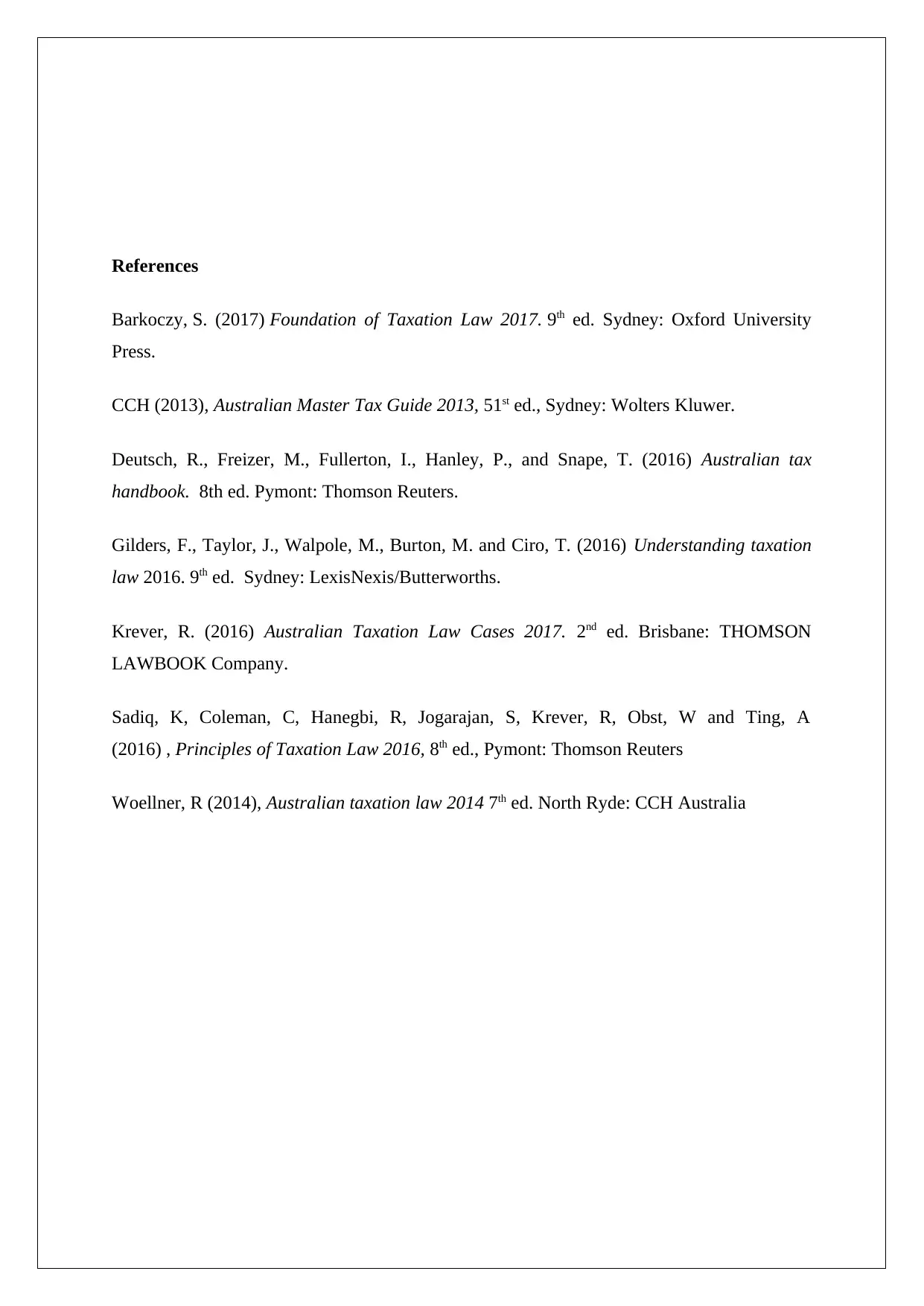
References
Barkoczy, S. (2017) Foundation of Taxation Law 2017. 9th ed. Sydney: Oxford University
Press.
CCH (2013), Australian Master Tax Guide 2013, 51st ed., Sydney: Wolters Kluwer.
Deutsch, R., Freizer, M., Fullerton, I., Hanley, P., and Snape, T. (2016) Australian tax
handbook. 8th ed. Pymont: Thomson Reuters.
Gilders, F., Taylor, J., Walpole, M., Burton, M. and Ciro, T. (2016) Understanding taxation
law 2016. 9th ed. Sydney: LexisNexis/Butterworths.
Krever, R. (2016) Australian Taxation Law Cases 2017. 2nd ed. Brisbane: THOMSON
LAWBOOK Company.
Sadiq, K, Coleman, C, Hanegbi, R, Jogarajan, S, Krever, R, Obst, W and Ting, A
(2016) , Principles of Taxation Law 2016, 8th ed., Pymont: Thomson Reuters
Woellner, R (2014), Australian taxation law 2014 7th ed. North Ryde: CCH Australia
Barkoczy, S. (2017) Foundation of Taxation Law 2017. 9th ed. Sydney: Oxford University
Press.
CCH (2013), Australian Master Tax Guide 2013, 51st ed., Sydney: Wolters Kluwer.
Deutsch, R., Freizer, M., Fullerton, I., Hanley, P., and Snape, T. (2016) Australian tax
handbook. 8th ed. Pymont: Thomson Reuters.
Gilders, F., Taylor, J., Walpole, M., Burton, M. and Ciro, T. (2016) Understanding taxation
law 2016. 9th ed. Sydney: LexisNexis/Butterworths.
Krever, R. (2016) Australian Taxation Law Cases 2017. 2nd ed. Brisbane: THOMSON
LAWBOOK Company.
Sadiq, K, Coleman, C, Hanegbi, R, Jogarajan, S, Krever, R, Obst, W and Ting, A
(2016) , Principles of Taxation Law 2016, 8th ed., Pymont: Thomson Reuters
Woellner, R (2014), Australian taxation law 2014 7th ed. North Ryde: CCH Australia
⊘ This is a preview!⊘
Do you want full access?
Subscribe today to unlock all pages.

Trusted by 1+ million students worldwide
1 out of 6
Related Documents
Your All-in-One AI-Powered Toolkit for Academic Success.
+13062052269
info@desklib.com
Available 24*7 on WhatsApp / Email
![[object Object]](/_next/static/media/star-bottom.7253800d.svg)
Unlock your academic potential
Copyright © 2020–2026 A2Z Services. All Rights Reserved. Developed and managed by ZUCOL.




